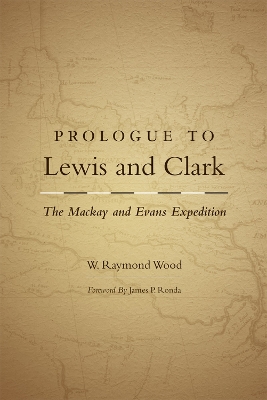American Exploration and Travel
2 total works
When Mackay and Evans returned to Spanish St. Louis in 1797, they were hailed as ""the two most illustrious travelers in the northern parts of this continent."" Ironically, though the findings of Mackay and Evans were responsible for much of the early success of Lewis and Clark in their expedition, the adulation that followed Lewis and Clark's successful return completely eclipsed Mackay and Evans's reputations. In Prologue to Lewis and Clark, W. Raymond Wood narrates the history of this long-forgotten but important expedition up the Missouri River.
The Mackay and Evans expedition was more than an exploratory mission. It was the last effort by Spain to gain control over the Missouri River basin in the decade before the United States purchased the Louisiana territory. In that respect, it failed. But the expedition was successful as a journey of exploration. The maps and documents they created later provided the Lewis and Clark expedition with invaluable information for its first full year.
Consolidating a collection of eighteen contemporary documents relating to the Mackay and Evans expedition as well as his own research and analysis, Wood provides an in-depth examination of the expedition's background, execution, and final results.
Volume 79 in the American Exploration and Travel Series
Early Fur Trade on the Northern Plains
by W Raymond Wood and Thomas D Thiessen
French, British, and Canadian traders were the first to arrive. Representatives of the Montreal-based North West Company were soon followed to the Missouri by employees of the rival Hudson's Bay Company, and for nearly thirty years the two groups competed for the beaver pelts collected by the Mandans and Hidatsas from tribes farther west.
Contact with the Canadian traders, and later with others who ascended the Missouri from Saint Louis, had a profound effect on the tribes, for it introduced Euro-American culture and trade goods that led to the extinction of their way of life.
There is especially good documentation of the dealings between the Mandans and Hidatsas and the whites for the period 1790 to 1806, when several literate traders visited the Indian villages and recorded their experiences and impressions in lively, colorful narratives. In this book are presented new, dependable, annotated transcriptions of five of the most important of these documents, the narratives of the traders John Macdonell, David Thompson, François-Antoine Larocque (two journals), and Charles McKenzie. Through the narratives and the editors' own thorough historical introduction, W. Raymond Wood and Thomas D. Thiessen reexamine the history of the fur trade in the North and provide fresh insight into that shadowy period. New maps show in detail the routes of the trader-narrators, and the appendix provides useful statistics, inventories, and financial accounts of the fur trade of the era.
Early Fur Trade on the Northern Plains will be of use not only to scholars of the fur trade and anthropologists but also to all those interested in the exploration and early history of the vast Northern Plains.

